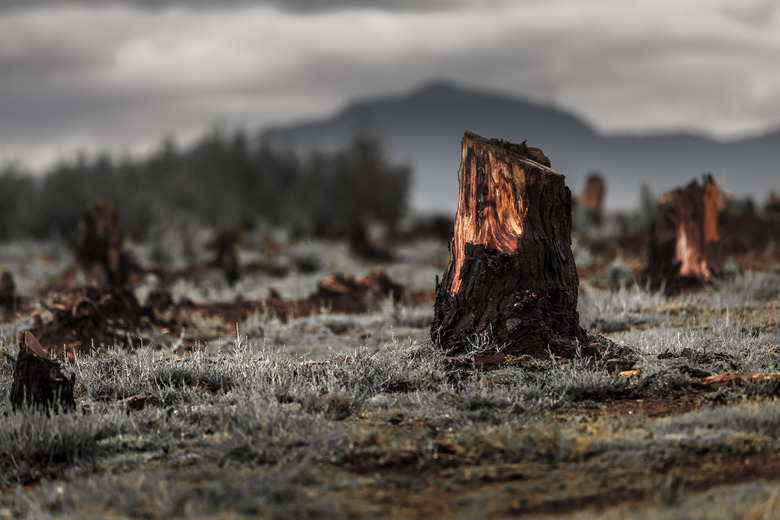Four Consequences Of Deforestation
Deforestation, which is the loss of wild forest habitats due to human activity, has grown into a global problem as demand for wood climbs. Shrinking forests can cause wide-reaching problems, including soil erosion, water cycle disruption, greenhouse gas emissions and biodiversity losses. Combined, these four issues affect not only wild plants and animals but human beings as well.
TL;DR (Too Long; Didn't Read)
Deforestation affects wild animals, plants and humans in at least four distinct ways: via soil erosion, which can lead to clogged waterways and other problems; via water cycle disruption, which can lead to desertification and habitat loss; via greenhouse gas emissions, which contribute to global climate change; and via biodiversity losses, which can lead to extinctions and loss of natural beauty.
Soil Erosion
Soil Erosion
It's easy to think of soil as compact and unmoving, but that isn't always accurate. Soil can be surprisingly loose, and it doesn't always stay in the same place. It can be washed away by rain or blown away by wind if it isn't properly anchored. What anchors the soil in place? The roots of plants, mostly. This is especially true of trees, which have roots large enough to anchor large swaths of soil. When humans clear large forests, soil erosion can become a serious problem. In some areas, eroding soil can lead to disastrous mudslides. Large amounts of soil can wash into local streams and rivers, clogging waterways and causing damage to hydroelectric structures and irrigation infrastructure. In certain areas, soil erosion issues caused by deforestation lead to farming problems and loss of reliable electric power.
Water Cycle Disruption
Water Cycle Disruption
The water cycle is the process by which all water on earth is distributed. Water from Earth's oceans as well as from the surface of bodies of fresh water evaporates and condenses into clouds. Trees and other plants also extract groundwater and release that water into the atmosphere during photosynthesis. Clouds then produce rain, which becomes both groundwater and – eventually ocean water again.
However, when large numbers of trees are cut down, the water they usually extract, store and release into the atmosphere is no longer present. This means that cleared forests, which once had moist, fertile soil and plenty of rain become barren and dry. This kind of change in climate is called desertification. Such dry conditions can lead to an increased risk of fire on peatland and great loss of life for the plants and animals that once lived in the forest.
Greenhouse Gas Emissions
Greenhouse Gas Emissions
Greenhouse gases such as methane and carbon dioxide are gases that trap heat in Earth's atmosphere, leading to global climate change. Fortunately, in addition to releasing oxygen and water into the atmosphere, trees also absorb carbon dioxide. While trees are still living, they function as efficient greenhouse gas filters. The moment they are cut down, the carbon dioxide that was stored in their trunks and leaves is released into the atmosphere, further contributing to the buildup of greenhouse gases. After trees are removed from a large piece of land, the carbon dioxide in that area can no longer be absorbed as it was before.
Global climate change, brought on by a buildup of greenhouse gases in Earth's atmosphere, affects wild animals, plants and humans via weather changes and increased likelihood of natural disasters. It is estimated that deforestation contributes as much as 30 percent to global greenhouse gas emissions each year.
Biodiversity Losses
Biodiversity Losses
Living things have mastered the art of adapting to new environments. This is how life on Earth manages to thrive from the Arctic tundra to burning hot deserts. However, it takes time for life to adapt. Deforestation alters land too quickly for plants and animals to cope, which means that many of them do not survive. If enough deforestation occurs, entire species can be wiped out. This loss of life is known as biodiversity loss.
Biodiversity losses affect ecosystems. For example, if a small species of frog becomes extinct, it could affect populations of predators such as birds who rely on the frogs for food. Certain plants might rely on the birds to spread their seeds and might also suffer population losses. Because each piece of an ecosystem relies upon other pieces, one species loss can have far-reaching consequences for other species.
It is worth noting that biodiversity losses can lead to what some would argue is deforestation's worst consequence of all – a loss of natural beauty and wonder. Wild forests are incredible places, filled with all sorts of life. In places like the Amazon, new species are discovered almost every year. This life is beautiful to behold and amazing to learn about, but it can only be protected if people work to put a stop to rampant deforestation.
Cite This Article
MLA
Cook, Maria. "Four Consequences Of Deforestation" sciencing.com, https://www.sciencing.com/four-consequences-deforestation-7622/. 19 April 2018.
APA
Cook, Maria. (2018, April 19). Four Consequences Of Deforestation. sciencing.com. Retrieved from https://www.sciencing.com/four-consequences-deforestation-7622/
Chicago
Cook, Maria. Four Consequences Of Deforestation last modified March 24, 2022. https://www.sciencing.com/four-consequences-deforestation-7622/
